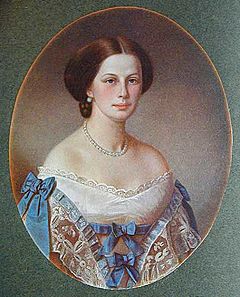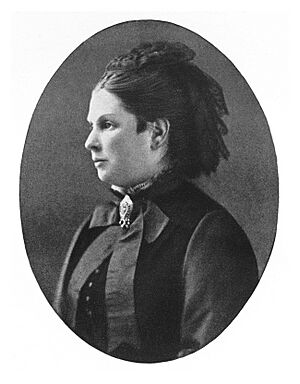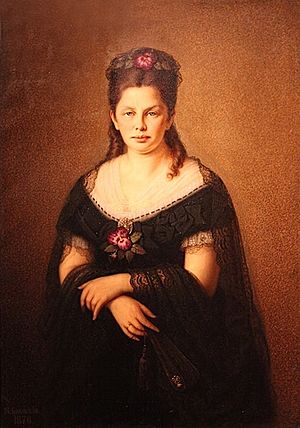Anna Filosofova facts for kids
Quick facts for kids
Anna Filosofova
|
|
|---|---|
 |
|
| Born |
Anna Pavlovna Diaghileva
August 5, 1837 Saint Petersburg
|
| Died | March 17, 1912 (aged 74) Saint Petersburg
|
| Children | Dmitry Filosofov |
| Relatives | Sergei Diaghilev (nephew) |
Anna Pavlovna Filosofova (Russian: Анна Павловна Философова; born Diaghileva; August 5, 1837 – March 17, 1912) was an important Russian woman. She was a philanthropist, meaning she helped people in need. She was also a feminist, which means she worked for equal rights for women. Anna was a key organizer of charity work. Along with Maria Trubnikova and Nadezhda Stasova, she helped start and lead the first organized women's movement in Russia.
Contents
Biography
Early Life and Family
Anna Filosofova was born in Saint Petersburg in 1837. Her family was wealthy and noble. Her father, Pavel Diaghilev, worked for the government. Later, he started a business. Anna was the youngest of nine children. She learned everything at home, which was common for noble families back then.
In 1855, Anna married Vladimir Dmitryevich Filosofov. He was a powerful government official. Anna and Vladimir had six children. One of their children was the writer Dmitry Filosofov.
Vladimir's family owned serfs. Serfs were like peasants who were tied to the land and had very few rights. When Anna visited their family estate, she saw how hard life was for poor peasants and serfs. This made her think about social problems. She started helping the poor by giving them food and medicine. Around this time, she met Maria Trubnikova. Maria was interested in social change and shared books about women's issues with Anna. Anna said Maria helped her learn and grow.
Helping Others and Women's Rights
In 1860, Anna, Maria, and their friend Nadezhda Stasova started a group. It was called the "Society for Cheap Lodging and Other Aid to the Residents of Saint Petersburg." They had a new idea for helping people. Instead of just giving money, they wanted to train and educate poor people. This way, people could learn skills and earn their own living.
Their society offered low-cost housing for poor women. They also found sewing jobs for these women from local businesses. The group even got a big contract to sew for the military. Anna and her friends also started other groups, like the "Society for the organization of Work for Women."
After the Crimean War, Russia made big changes to its education system. More schools opened, including some for girls. Anna and her friends were part of discussion groups that talked about literature and social issues. Maria Trubnikova knew about women's rights movements in other countries.
Anna and her friends had a big goal: to get higher education for women. In 1867, they sent a petition to Tsar Alexander II. It had four hundred signatures. They asked to open the first higher education courses for women at Saint Petersburg State University. Many people did not want women to go to university. However, the Education Minister allowed women to attend some lectures for free. These informal classes started in 1871. They were called "Vladimirsky courses." Many people in high society did not like these courses. Some women even went abroad to finish their education. The courses closed in 1875.
But Anna did not give up! In 1876, she got official permission to open the first Russian women's university. It was known as the Bestuzhev Courses. It was named after its founder, Konstantin Bestuzhev-Ryumin.
Later Life and Achievements
Anna was known for being kind and generous. People often asked her for help, especially families of revolutionaries. Russian officials did not like her helping these people. In 1879, she was sent out of the country for helping revolutionary groups. She was allowed to come back in 1881.
After the Tsar was assassinated in 1881, Anna found it hard to get support for new projects. Her husband's job was also affected because of her connections. The family had to live more simply.
Anna returned to public life in the late 1880s. She helped people who were starving in the Volga Region. In 1892, she joined a group that helped people learn to read and write. In 1895, she started and led the "Charity Association of Russian Women." This was a feminist group, but it was officially called a charity. This was because political groups were not allowed in Russia at the time.
The same year, a women's medical university opened in Russia. In 1904, women's university courses were allowed again outside the capital city. Anna was recognized by the Tsar for her work in helping to fund women's education. In 1905, Russian universities opened their doors to women. This meant the women's university courses were no longer needed. Also in 1905, men were allowed to vote, and political activity became legal. After this, women's groups asked for women to be allowed to vote too.
Anna became chairman of the International Council of Women in 1899. She took part in the Russian Revolution of 1905. She joined a political party and later led the first Russian women's congress in 1908. Anna wanted to unite Russian women, but it was hard because there were many different groups.
After the congress, Anna and her friends received mean letters from a politician named Vladimir Purishkevich. Anna made the letter public and took him to court. He was sentenced to one month in jail.
In 1908, Anna joined the Russian Theosophical Society, which she had helped to create. In 1911, Russia celebrated Anna's fifty years of public work. This celebration showed how much the women's movement in Russia had grown. Over one hundred women's groups attended, along with groups from other countries. She was also honored by politicians at the Mariinsky Palace. Anna Filosofova died in Saint Petersburg in 1912. Thousands of people attended her funeral.
See also
 In Spanish: Anna Filosófova para niños
In Spanish: Anna Filosófova para niños



